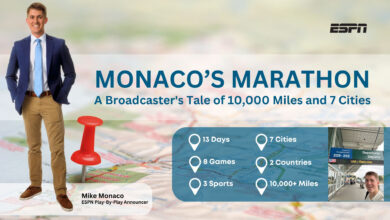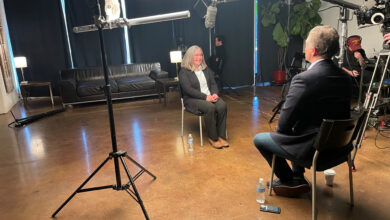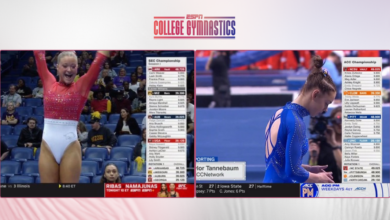Tremendous teamwork often is the result of excellent communication.
Gallaudet University quarterback Brandon Washington and Bison head coach Chuck Goldstein exemplified that sentiment on a recent overcast Saturday in Washington, D.C.
In the first quarter of Gallaudet’s Oct. 7 home game against Hilbert, Goldstein relayed a play. The coach didn’t use radio waves, hand signals or billboards to send the call to his players, many of whom are deaf or hard of hearing.
Instead, Goldstein relayed the play via a computer tablet; Washington shared the play to his teammates as it appeared in augmented reality on a tiny screen in his first-of-its kind 5G-connected football helmet, technology that’s the result of a 21-month collaboration between AT&T and Gallaudet.
The result of the play: Washington scored on a 63-yard run that sparked a 34-20 come-from-behind victory.
“As Coach Chuck said, this is a game-changer for all deaf and hard-of-hearing football players,” said Scott Klatskin, Assistant Vice President of Marketing Communications, AT&T, of the helmet.
Before, during and after the play that will prove to be another historic Gallaudet contribution to football’s evolution – in 1894, Bison quarterback Paul Hubbard invented the modern day huddle – The Walt Disney Company (TWDC) helped spread the exciting news about AT&T’s groundbreaking helmet.
How does the AT&T 5G Helmet work? Glad you asked. It’s changing the game for Deaf and Hard of Hearing players. #ConnectingChangesEverything #CollegeFootball pic.twitter.com/XQS9ljbJzx
— AT&T (@ATT) October 7, 2023
In October, which is widely recognized as National Disability Employment Awareness Month (NDEAM), AT&T debuted the technology to the sports community across several Disney and ESPN platforms: On Oct. 5, the helmet was showcased in a segment on ABC’s Good Morning America; on Oct. 7 and Oct. 14, ESPN’s College GameDay featured vignettes explaining the technology; on Oct. 21, SportsCenter also introduced the informative “Sound Of Silence” spot.
“To see this team, our players and University featured on ESPN’s College GameDay and Saturdays during the college football season is unbelievable,” said Goldstein, whose team received a special NCAA waiver and Hilbert’s sign off to use the technology in the game. “We didn’t think this would turn into what it has, but it has been amazing and a positive thing for Gallaudet and the entire deaf and hard of hearing community.”
Disney Advertising collaborated with AT&T, ESPN and ABC production teams to bring the innovative 5G Helmet story to life. Gallaudet worked closely with AT&T, providing feedback for refinement and possible use of the helmet in future seasons. This technology could translate to use throughout football and other sports that use helmets, AT&T’s Klatskin said, and perhaps even have myriad benefits beyond sports.
Front Row asked about the storytelling and the exciting prospect for the 5G Helmet to redefine communication in sports and beyond.
How did this collaboration with AT&T, Disney Advertising, and ESPN/ABC production come about?
Vice President, Disney Advertising, Sports Brand Solutions, Theresa Palmieri: AT&T is a long-standing official sponsor across the College Football Playoff and College GameDay. AT&T and ESPN/Disney are always trying to work together to find new ways to innovate and leverage 5G technology within ESPN’s College Football content to elevate the fan viewing experience.
This year, AT&T partnered with Gallaudet University and [ad agency] Translation to develop a 5G-powered helmet to help the deaf and hard of hearing.Then, as part of their College Football sponsorship program this year, AT&T brought this to ESPN/Disney to help tell and amplify this story to reach Disney’s vast audience. Getting the word out on this incredible innovation was very important to all the involved parties.
How did College GameDay approach incorporating the AT&T 5G Helmet spot into its storytelling?
Matthew Garrett, coordinating producer, College GameDay: It’s a priority for College GameDay to cover the entire tapestry of college football and to share with our viewers unique stories from programs both large and small. Being able to feature Gallaudet University’s continued innovation of the game, through its partnership with AT&T, fits perfectly within that mission.
How did Translation approach this initiative and the storytelling surrounding it?
Chaucer Barnes, Chief Marketing Officer at Translation: When this project started, we realized elite DHH [Deaf or Hard of Hearing] players saw an innovation already adopted by the game of football – the radio that connects a quarterback to the sideline – as a ceiling to their own achievement. Our real privilege here was to relevel that playing field with a creative solution that doesn’t arrest old innovation, but powers new innovation through AT&T’s 5G technology. The benefit is immediately evident on Gallaudet’s field, but we’re most excited as we consider the talent of tomorrow being able to aspire to any position on any field.
What future plans are there to use the helmet at Gallaudet?
Chuck Goldstein, head football coach, Gallaudet: The next steps are for us to provide feedback to the NCAA about our experience using the helmet as far as how things went, what needs to be improved, what worked well, etc. Our hope and goals are to be able to use this helmet for an entire season in the future to help level the playing field for deaf and hard of hearing student-athletes.
What’s been the public and media’s response to AT&T’s collaboration with Disney Advertising and ESPN/ABC production?
Scott Klatskin, AT&T: We knew we had something special early on based on the reactions from the Gallaudet coaches and players. But it was amazing to see it in action during the game and to see how the world is reacting to the story. Between us and Gallaudet, we’re fielding interest and requests from all over the country. It’s clear that the helmet is inspiring others on what’s possible with this technology.
What’s the next step for the 5G Helmet?
Klatskin: As a connections company, we would love to see a technology like this adopted across mainstream sports and are working on ways to make that possible. The applications for a 5G-connected helmet could open possibilities of inclusion for any sport that requires helmets. But even more possibility exists in any environment where there’s a need for a helmet and instant communication. Could a 5G-connected helmet improve safety on construction sites or for first responders – and even potentially lead to more and even potentially lead to more job opportunities for the deaf community?
Bukola Oyalabu, Kristen Smith, Liza Falk Berger and Julie McKay contributed to this post







